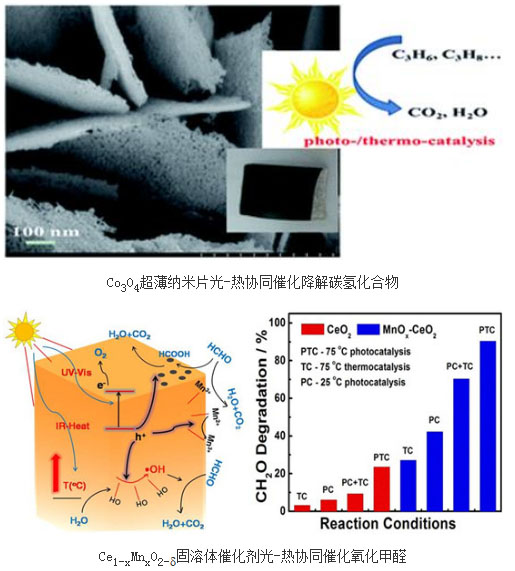The indoor decoration materials released by formaldehyde, volatile organic compounds such as benzene series (VOCs), automobile emissions of hydrocarbons, nitrogen oxides, etc. can cause serious air pollution. Photocatalytic technology can be used to purify gas-phase pollutants, and has the characteristics of no secondary pollution, sustainable use, etc., and has received extensive attention. However, after years of research, photocatalytic technology still has a large gap from practical application. Most of the photocatalysts can only absorb ultraviolet light and a small part of visible light, and the quantum efficiency is low. About 48% of the infrared light energy in sunlight energy cannot be used to excite photocatalytic materials, but only convert to heat and raise the ambient temperature. In order to improve the utilization of solar energy by photocatalysis, Wang Wenzhong, a researcher at the Shanghai Institute of Ceramics, Chinese Academy of Sciences, and Dr. Jiang Dong and Zheng Yali, Ph.D., proposed the use of infrared-band energy in a photocatalytic manner and under UV-Visible excitation. Photocatalytic coupling results in synergistic catalytic efficiency that far exceeds a single catalytic process. The mesoporous Co3O4 ultrathin nanosheets prepared by the research group far exceeded the degradation rates of propane and propylene hydrocarbons (72%, 90%) as compared to Co3O4 powders (0, 17.7%) and TiO2 powders. (0, 50%) (J. Mater. Chem. A, 2016, 4, 105). Based on the photocatalytic properties of Co3O4 and the Mars-van Krevelen redox cycle, Co3O4 can act as a photocatalyst while passing light. The thermal effect reaches its thermocatalytic light-off temperature (up to 180 oC) and exhibits photo-thermal synergistic catalytic degradation. In recent years, the research group has systematically studied the synergy mechanism between light and thermal catalysis, and has made a series of progress. Among them, coupling electron and ion-conducting CeO2 helps to improve the negative effect of temperature increase on the photo-electric conversion, thereby achieving a photo-thermal synergistic catalytic activity of 1+1>2. The related results include: (1) The introduction of Bi into CeO2 significantly improves visible light absorption and low temperature reducibility, and exhibits low-temperature (25-75 oC) light-heat synergy and rate constant under light-heat interaction in formaldehyde degradation ( The superposition of 0.22 h-1) far more than single light (0.08 h-1) and hot (0.06 h-1) catalytic processes indicates that photo-thermal cocatalysis can effectively utilize infrared energy in sunlight (J. Phys. Chem. C, 2013, 117, 24242); (2) The introduction of Mn to CeO2 further enhances the spectral absorption, photo-thermal effect, low-temperature reducibility, and photo-thermal synergistic catalytic activity for formaldehyde oxidation, and the deactivated catalyst can be Regeneration by photocatalytic processes (Appl. Catal. B-Environ., 2015, 165, 399). Related research work has been supported by the National Key Basic Research Program of the Ministry of Science and Technology and the Natural Science Foundation of China. Stainless Deep Drawing Parts,Custom Metal Fabrication Deep Drawing,Filter Cover Metal Fabrication,Custom Sheet Metal Deep Drawing JIANGSU TONGDE INTERNATIONAL TRADE CO.LTD. , https://www.tongdetrades.com